The surge of interest in “action” activities such as climbing walls and challenge/ninja courses in recreation facilities can be attributed to the healthy benefits such offerings can provide, both physically and mentally.
Recreation equipment manufacturers and facility administrators have recognized this trend and are responding accordingly with creative fitness products and programs, creating “wow” experiences, and attracting new users, while helping to spur customer retention.
“Climbing is an alternative form of exercise, and usually once people do it, they realize how beneficial it is for a full-body workout,” said Adam Koberna, president of a climbing wall company with U.S. offices in Pittsburgh, Pa. “It’s also a mind workout, a challenge. Most routes on a climbing wall are called problems (that is what climbers call them). As a climber, you are always trying to figure out a problem, and that adds another element to it. I also think a wall adds aesthetics to a building. If you do it right, it can add a sense of architecture.”
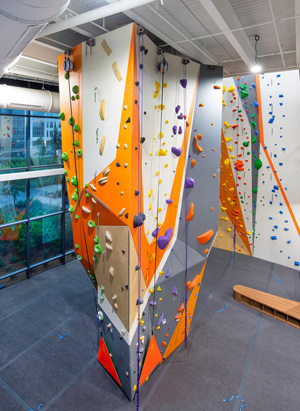
Climbing walls have a number of benefits, according to Kevin Volz, CEO of a Louisville, Colo., designer, manufacturer, and installer of climbing walls. “It is the physicalness of it, the fitness and strength aspect of it. That’s what climbing is, figuring out sequencing for your body. We see it in recreation centers, especially where there’s youths, kids climbing on it. There is self-esteem that gets built out of accomplishing something—camaraderie, teamwork. Climbing is a very social sport and it tends to be more collaborative and supportive than competitive.”
As a multigenerational sport, added JoAnne Carilli Stevenson, marketing director for a Bend, Ore.-based climbing wall company, “climbing walls offer a unique opportunity to engage individuals of all ages, skill levels, and fitness levels. Climbing is a full-body workout that combines strength, agility, flexibility, and endurance, which all support overall fitness. Beyond the physical benefits, climbing requires strategy, and focus, providing mental engagement alongside the physical challenge.”
Another reason to have a climbing wall as an offering in your facility is that it is a good investment, Volz said. “We generally don’t know how long they last. The surface might need some maintenance and repair over time, but climbing walls built back in the 1990s are still up and running. We know climbing walls will last 30 years, maybe longer than that. They might last as long as the building they are in. The ROI on this is good.”
Ninja courses are also growing in number. Patterned after the popular ninja challenges on TV, there are more than 400 ninja courses in the U.S. as of June 2023, according to Ninja Guide.
Ninja courses cater to a demographic often missed by community facilities: teens, according to Allison Abel, marketing director for an Anaheim, Calif.-based outdoor fitness and ninja-related equipment company. “Though teens still long to play with their friends, the playgrounds that are commonly found all over cities no longer fill that need for them,” she said. “Ninja courses provide challenges that captivate teens’ attention while giving them a positive outlet for seeking thrilling experiences. At the same time, their fun is productive as it keeps teens active and allows them to stay social, contributing to their overall wellness.”
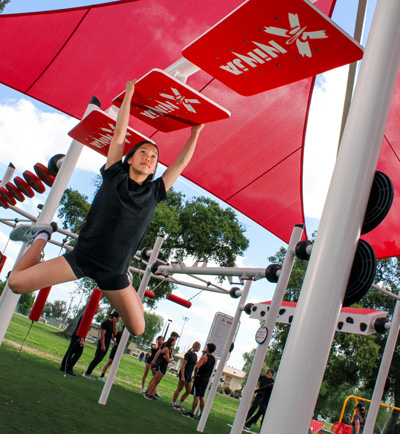
There are several ways to incorporate climbing walls and ninja-like courses into an existing facility. But there are constraints, say manufacturers: Climbing walls take up space, so it is rare to install a climbing wall in an existing recreation center, Volz said. “Occasionally that happens. More often than not it is a brand new recreation center and during design, it becomes part of the initial blueprint plan. Sometimes we collaborate with architects on the front end, informing them of the space needed and other requirements. Typically those jobs will go out to bid as part of the whole package as they try to find a general contractor and all the subcontractors.”
Space is certainly a constraint, but climbing wall manufacturers have come up with a variety of strategies for working around space challenges. “If you have an existing basketball court,” Volz explained, “you can put a climbing wall in that is fairly flat and doesn’t impede the basketball court. We call those low-profile, low-depth options.”
If you don’t have a lot of space in your facility, Koberna said, “there are smaller climbing walls, so-called training boards that are moveable, and the angles can be adjusted. Beginners to advanced people can climb them and all within a space that is fairly small. The climbing surface is usually 12x12 or 14x12. The structure and the space around it is not a large footprint.”
If space is limited, think about installing a bouldering or an adjustable training wall, said Stevenson. “A bouldering wall can feature specific routes or just a spray wall (a bouldering wall that is densely packed with a variety of holds) that allows climbers to design their own problems choosing from all holds on the wall.”
Since bouldering doesn’t require ropes or additional equipment like harnesses and belay devices, it simplifies the integration, she said.
For ninja, indoor space tends to be hard to come by, especially with an existing facility. But if you have space outdoors, you can find options that will easily engage teens and other adventurous patrons.
New Facility Considerations
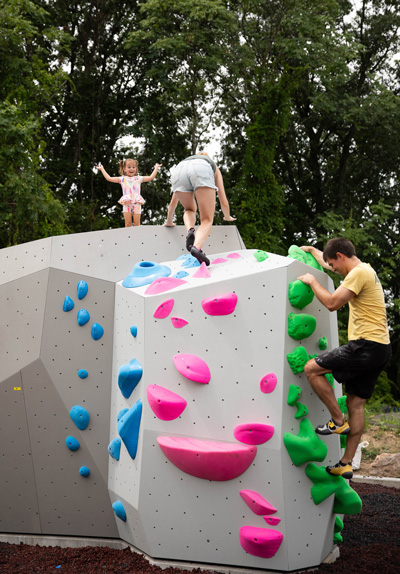
Focus on safety and design when including a wall in a new facility, Stevenson said. It’s important to consider your facility’s layout and how climbing will integrate into the flow. “Identify where you want to incorporate climbing walls within the larger facility to ensure they complement other activities. Consider the demographics of the climbers you want to attract to align your design and wall features to meet their needs and ability levels,” she added.
The climbing wall location should consider height, width, and fall zones to ensure accessibility and safety. “An engaging space will have clear zones, separating climbing from high-energy obstacles, or smooth transitions where participants can easily move between climbing and other challenges.”
With their impressive appearance and ability to stop people in their tracks as they watch the action, climbing walls can often become the focal point of the building, but don’t wait until the last minute to hire your climbing wall design, manufacturing, and installation team. “Savings can be had when the climbing wall engineering is incorporated into the building’s engineering, and everybody is working together,” Koberna said. “To me, the number one thing to take away is the integration of structure and engineering. It can save dollars.”
While planning, consider the community you’ll be serving: Who are your clients? “There are pockets where people are climbing everywhere,” Volz said, with schools and rec centers being hubs of climbing activity. “In Colorado, climbing is part of the outdoor lifestyle; in the inner city, Manhattan, maybe not so much,” he added.
Once you understand your audience, you can focus on your space and budget to build out the best option for your particular audience. “Climbing walls can be built for under $10,000 and take up very little space,” Volz said. “We can also add a couple of zeros to that. We have built million-dollar climbing walls. It comes down to what is your suite of offerings, and what does the building allow?”
For larger climbing walls, you’ll need to consider other infrastructure, such as an area for shoe and harness rental, as well as a check-in desk where climbers can sign waivers. Things not taken into account when people carve out a space for a climbing wall include egress, fire escapes, and HVAC, Koberna explained. All that eats into the overall space. “We have gone into rec centers where usually the people who suffer the most are the advanced climbers, because they need steeper terrain and if you don’t have the space in front of your climbing wall the climbing wall becomes more and more vertical and less steep. Pay attention to the demographics of your users.”
YMCAs are different, he explained. “We have done YMCAs, and in those cases we incorporate kids’ elements into YMCA walls, in the climbing zone. Try to separate the kids from the other climbers, whether in a large or small gym. People want that separation,” Koberna said. “We see that every time we build a gym. We might place the kids’ area near the auxiliary rooms so that they have a place to go. Sometimes there are separate bathrooms there as well. It’s a way of funneling traffic and managing the space that isn’t the climbing wall.”
Route-setting is a crucial element of climbing facility success, but there are other important considerations. Good facilities allow people to hang out and sit around, whether working on their laptop, using their smartphone or simply socializing with others in the climbing zone, Koberna said. “That is what makes a good facility, and usually, scaling back the climbing wall, just a little bit, giving more social space will make it a very successful facility.”
When it comes to ninja courses, having a variety of obstacles makes them more versatile for a community with a wide range of athletic capabilities, Abel said. “For instance, someone newer to their fitness journey might want to start out on easier obstacles, whereas higher-level athletes might be more drawn to features that push their limits. In every design, try to incorporate something that caters to just about everyone.”
Marketing and Monetizing
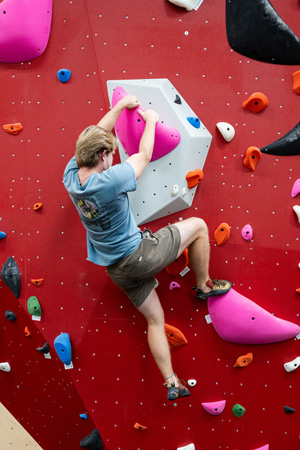
Once you’ve got your climbing wall in place, you need to get the word out to potential visitors. “There is this whole world that is emerging that is generically known as ‘fun climbing,’ that is part of the bigger picture of active entertainment.” Volz said.
Stay true to your business plan, concept and target audience, Stevenson said. “Attract newcomers by offering intro days or learn-to-climb classes to expose the larger community to your facility. To reach different demographics, consider scheduling specific family-friendly or adult-focused classes or time slots.”
Climbers will also continue to come back when they know there is a regular and interesting route-setting. Adult climbing training programs or teams can also boost engagement and retention.
As climbing has grown in popularity, with the sport included in the 2020 and 2024 Olympic games, people are more aware of the challenges, so the route-setting aspect running a climbing wall “is a really big deal,” Volz said. “It is also the biggest struggle for the industry. There are not enough route-setters out there, so they are in high demand. People who run gyms struggle with it, but that is what keeps people coming back.”
In a typical climbing gym, route-setters might change the routes monthly or bimonthly so that the next time clients come back there is a new route—another problem for them to solve.
Historically, climbing facilities haven’t always addressed the social potential of the sport. “When I started climbing it was a bit elitist,” Koberna said. “It was a grungy, dungeon basement place where people trained and music was loud. If you weren’t in the ‘club’ you didn’t go. You weren’t invited. That is totally different now and inclusive. This keeps people coming back.”
Where is the industry heading? Not necessarily up. Climbing walls of 40 feet or more might be impressive, but not really necessary. “It’s a wow factor, and there is nothing wrong with that,” Koberna said. “But a 35-foot wall for 80% of people is just fine. So, walls that are wider, capping at 35 to 40 feet are fine.”
There are people who will build “eye candy,” but they’ll drop it down and will have more of that moderate terrain, Volz said. Modern designers are including few features, so the walls themselves are big, flat planes, which allows the route-setters to be more creative. They are changing the shape of the walls with really large handles. If you build in many features you are stuck with what you have. “The trend is to go with fewer features, and more big, expansive planes.”
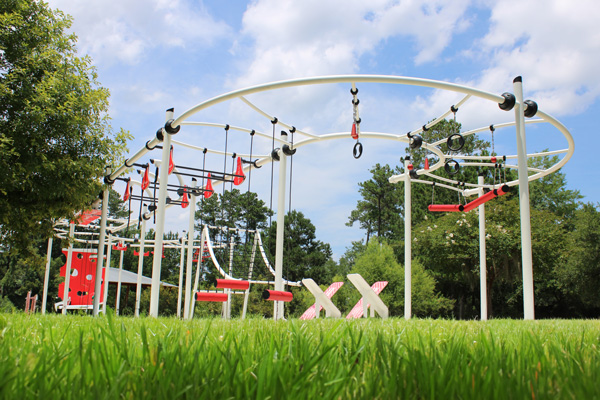
Safety will always be an important consideration. It is an ongoing challenge to ensure visitors are using the belay properly, that equipment is up-to-date and well-maintained, that flooring provides proper fall protection—all of this plays into a successful operation.
The desire for climbing walls is not going to decrease, Koberna said. “Since the Olympics, we’ve seen the awareness of facilities with climbing walls jump very high. I think the municipalities, the YMCAs are more on an uptick now.”
Find Your Ninjas
To attract newcomers to a newly installed ninja course, Abel said, “facility owners and directors can use multimedia channels to spread the word, then host a grand opening event to increase the hype surrounding the installation. From there, the quality of your course should speak for itself, but facilities can also schedule classes and events that build using the equipment into the daily lives of community members.”
Another great way to keep people interested, she said, is by updating the surrounding features of the facility, ensuring that there’s something for everyone so that whole families can enjoy their time out of the house together.
Ninja courses are still relatively new and have continued growing in popularity in recent years, “and we expect the surrounding excitement to continue increasing the amount of ninja courses and obstacle courses seen in community spaces,” Abel said. RM


